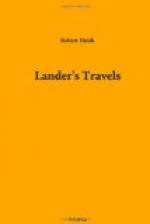It must be remarked in this place, that at the time when Adams related the narrative of his residence in Africa, and particularly in the city of Timbuctoo, a very considerable degree of distrust was attached to it; and in order to put the veracity of Adams to a decisive test, the publication of his adventures was delayed until the arrival of Mr. Dupuis, then the British vice-consul at Mogadore, to whose interference Adams acknowledged himself indebted for his ransom, and who, on account of his long residence in Africa, and his intimate acquaintance with the manners and customs of the natives, was fully competent to the detection of any imposition which it might be the intention of Adams to practise upon those, who undertook the publication of his adventures. From this severe ordeal Adams came out fully clear of any intention to impose, and the principal points of his narrative were corroborated by the knowledge and experience of Mr. Dupuis. Thus that gentleman, in allusion to the description which Adams gave of La Mar Zarah, mentions that the Spanish geographer Marmol, who describes himself to have spent twenty years of warfare and slavery in Africa, about the middle of the sixteenth century, mentions the river La-ha-mar as a branch of the Niger, having muddy and unpalatable waters. By the same authority, the Niger itself is called Yea, or Issa, at Timbuctoo, a name which D’Anville has adopted in his map of Africa.
The vessels used by the natives are small canoes for fishing, the largest of which are about ten feet long, capable of carrying three men; they are built of fig-trees hollowed out, and caulked with grass, and are worked with paddles about six feet long.
The natives of Timbuctoo are a stout healthy race, and are seldom sick, although they expose themselves by lying out in the sun at mid-day, when the heat is almost insupportable to a white man. It is the universal practice of both sexes to grease themselves all over with butter produced from goat’s milk, which makes the skin smooth, and gives it a shining appearance. This is usually renewed every day: when neglected, the skin becomes rough, greyish, and extremely ugly. They usually sleep under cover at night, but sometimes, in the hottest weather, they will lie exposed to the night air, with little or no covering, notwithstanding that the fog, which rises from the river, descends like dew, and, in fact, at that season supplies the want of rain.
All the males of Timbuctoo have an incision on their faces from the top of the forehead down to the nose, from which proceed other lateral incisions over the eyebrows, into all of which is inserted a blue dye, produced from a kind of ore, which is found in the neighbouring mountains. The women have also incisions on their faces, but in a different fashion; the lines being from two to five in number, cut on each cheek bone, from the temple straight down; they are also stained with blue. These incisions being made on the faces of both sexes when they are about twelve months old, the dyeing material, which is inserted in them, becomes scarcely visible as they grow up.




